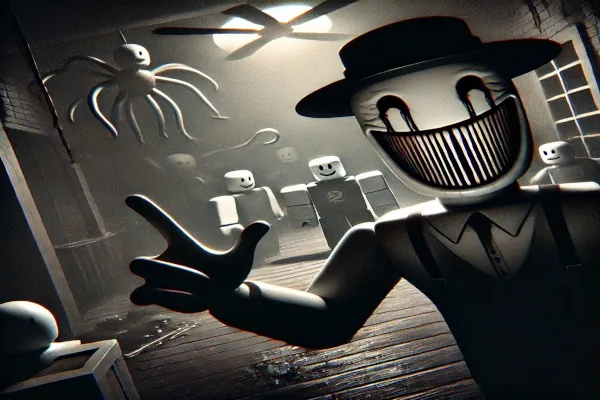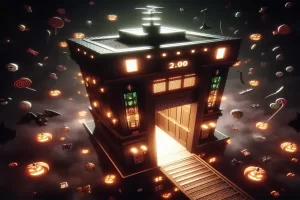The Roblox platform is home to an impressive variety of user-generated games, with one genre standing out for its ability to send chills down players’ spines: horror. Among the many terrifying experiences available, The Mimic has emerged as one of the most unsettling and captivating horror games on the platform. Known for its intense atmosphere, supernatural themes, and psychological terror, The Mimic has gained a reputation as one of the scariest titles in Roblox‘s horror scene.
What makes The Mimic particularly terrifying is its ability to blend eerie environments, dark folklore, and a progressively horrifying narrative that keeps players on edge from start to finish. Its chilling storylines, unpredictable jump scares, and immersive atmosphere make it a standout title that horror fans can’t help but gravitate toward.
In this post, we’ll explore the elements of The Mimic that make it such a captivating experience for horror fans, from its eerie visuals to its nerve-wracking gameplay. If you’re ready to dive into a world of fear and suspense, read on to find out why The Mimic continues to terrify and captivate players around the globe.
What is The Mimic?
Game Overview
The Mimic is a captivating and spine-chilling horror game on Roblox that draws players into a world inspired by Japanese folklore. The game is structured around multiple chapters, each one presenting its own terrifying narrative and environment. Players explore eerie settings, solve puzzles, and uncover a dark, unfolding story while evading terrifying creatures that lurk in the shadows. Each chapter is progressively more intense, keeping players on edge with a mix of psychological horror and supernatural threats. The gameplay revolves around exploration, puzzle-solving, and the constant need to hide or escape from lurking monsters, making for a truly immersive horror experience.
The game’s mechanics are straightforward yet effective. Players navigate through dark corridors, rooms, and environments while interacting with objects that unlock new areas and clues. The heart-pounding chase sequences, where players must hide or outrun enemies, create a sense of tension and fear. The unpredictable nature of the game ensures that no two experiences are the same, with random events and monsters keeping players on their toes throughout each chapter.
Origins and Development
The Mimic was created by a talented developer on Roblox who drew inspiration from classic horror games and Japanese mythology. The game’s early popularity was fueled by its unique blend of storytelling and atmosphere, coupled with its ability to evoke a deep sense of dread. Influenced by real-world folklore, particularly ghost stories and spirits from Japanese culture, The Mimic incorporates traditional elements like vengeful spirits, eerie rituals, and unsettling creatures, all of which contribute to its spine-chilling experience.
The game initially gained attention for its innovative approach to horror on Roblox, where most titles in the genre focused on jump scares or survival mechanics. The Mimic set itself apart by embracing atmospheric horror, rich storytelling, and cultural references, creating an immersive experience that appealed to both casual players and horror enthusiasts alike. Its unique blend of folklore, terrifying creatures, and gameplay mechanics quickly earned it a devoted fanbase and cemented its place as one of the scariest games on the platform.
The Horror Elements That Define The Mimic
Atmospheric Design
The atmosphere in The Mimic is one of the most crucial elements that makes it so terrifying. From the moment players enter the game, they are immediately immersed in an eerie world filled with haunting visuals and unsettling sounds. The environments are expertly designed, with dark corridors, abandoned rooms, and oppressive spaces that make players feel small and vulnerable. The lighting is dim and strategic, casting long shadows and creating a sense of constant unease. Every flicker of light, every dark corner, builds suspense, making players feel like something terrifying is always lurking just out of sight.
Sound design plays an equally significant role in The Mimic. The eerie, atmospheric music, coupled with subtle ambient noises like creaking doors, distant whispers, and footsteps, heightens the tension. The game’s reliance on sound cues not only directs the player’s attention but also keeps them on edge. The sudden loud noises, like the crash of a door or the screech of a nearby creature, trigger a physiological response, ramping up the fear factor. All these elements come together to create a chilling atmosphere that pulls players deeper into the experience, making it impossible to ignore the fear creeping up around every corner.
Themes Drawn from Japanese Folklore
The Mimic draws heavily from Japanese folklore, which is rich with supernatural elements, spirits, and myths. The game features various terrifying creatures rooted in these traditional tales, such as vengeful spirits (yūrei), demons (oni), and other eerie entities that have been a part of Japanese culture for centuries. These mythological beings are not just included for their shock value; they are woven deeply into the game’s narrative and play an essential role in building its unsettling atmosphere.
For example, spirits in Japanese folklore are often portrayed as restless souls seeking revenge or redemption, and The Mimic uses this concept to create an emotional and psychological connection to the monsters. The spirits players encounter are not just monsters to be avoided; they are part of a greater, tragic story. This infusion of folklore into the game’s narrative enhances the horror by making each encounter feel personal, tied to something ancient and otherworldly. The spirits and demons are often portrayed in a way that taps into universal fears, making them both relatable and nightmarishly alien at the same time.
Unpredictable and Relentless Scares
One of the hallmarks of The Mimic is its ability to keep players on edge with its unpredictable scares. The game masterfully blends both jump scares and psychological horror, creating a tension that builds and releases in ways players don’t always anticipate. Jump scares are deployed at just the right moment, often triggered by the player’s actions or simply when they least expect it. However, it’s not just the sudden shocks that make The Mimic terrifying — the psychological elements linger long after the scares have passed. The sense of being constantly watched, the unsettling sounds that follow players from room to room, and the knowledge that something is always waiting just beyond the next door keep players in a state of perpetual fear.
The game’s unpredictability is one of its greatest strengths. The randomization of monster appearances, sudden environmental changes, and the surprise of encounters with different supernatural entities all contribute to the game’s relentless fear factor. Players can never truly relax, knowing that danger could strike at any moment, adding to the game’s sense of urgency and dread. This unpredictability ensures that every playthrough of The Mimic feels fresh, with players never knowing exactly when or where the next terrifying moment will come from.
Challenging Gameplay and Puzzle-Solving
Complexity of Puzzles and Tasks
In The Mimic, gameplay is not just about surviving terrifying monsters — players are also tasked with solving complex puzzles and completing intricate tasks that keep them deeply engaged. These puzzles often require keen observation, logical thinking, and sometimes even a bit of trial and error. The environment itself is designed to be a puzzle, with clues hidden in plain sight, cryptic messages, and objects that must be interacted with in specific ways to unlock the next area or piece of the story.
What makes the puzzles particularly challenging is that they are not just mental exercises; they are interwoven with the game’s tense atmosphere. As players explore dark and abandoned areas, the pressure mounts. The constant fear of encountering a monster or triggering a jump scare adds an extra layer of difficulty to solving the puzzles. Every wrong move, every moment of hesitation, can result in deadly consequences, and players must balance the need for quick action with the careful consideration of their surroundings. This combination of action, exploration, and problem-solving creates a dynamic gameplay experience that ensures The Mimic remains gripping throughout.
The Importance of Teamwork in Multiplayer
While The Mimic can be enjoyed solo, it truly shines in multiplayer mode, where teamwork is essential for success. The cooperative nature of the game encourages players to work together to solve puzzles, evade monsters, and survive the nightmarish world they find themselves in. Each player brings a unique set of skills to the table, and only by collaborating can the group hope to progress through the game’s increasingly difficult chapters.
Teamwork becomes particularly vital during encounters with powerful creatures, where one player’s distraction or quick thinking can mean the difference between survival and death. However, the cooperative nature of The Mimic also introduces a level of vulnerability — players must rely on one another to stay safe. The tension increases as players face monsters that are not only dangerous individually but also capable of ambushing the group, forcing everyone to constantly watch each other’s backs. Communication, coordination, and trust become key components of gameplay, heightening the suspense and reinforcing the feeling of helplessness and fear that makes The Mimic so terrifying.
In multiplayer mode, the fear factor is compounded by the need for constant vigilance. Not only do players need to survive the horrors of the game, but they also need to ensure the survival of their teammates, making every encounter more intense and suspenseful.
The Monsters and Enemies in The Mimic
Fearsome Enemies Inspired by Folklore
One of the standout features of The Mimic is its terrifying roster of enemies, many of which are inspired by ancient Japanese folklore. These mythological creatures are designed to not only scare but also draw on deep cultural beliefs that resonate with fear on a primal level.
- Onryo: One of the most chilling enemies in the game, the Onryo is a vengeful spirit with a tragic backstory. In Japanese culture, the Onryo is known for its ability to curse and bring harm to the living. In The Mimic, it appears as a ghostly figure with long, unkempt hair and an unsettling, twisted form. Its appearance is often accompanied by a sense of dread, and it’s known for its unpredictable movements, creating an air of constant threat.
- Kuchisake-onna: Another infamous creature inspired by Japanese urban legends, the Kuchisake-onna (meaning “slit-mouthed woman”) is a terrifying monster with a disfigured mouth that extends from ear to ear. According to the folklore, this vengeful spirit wears a mask to cover her deformed face, and she asks her victims if they think she’s beautiful. If they answer wrong, she reveals her true, horrific face. In The Mimic, the Kuchisake-onna stalks the players, forcing them into unsettling encounters where survival is never guaranteed.
These enemies, along with others drawn from Japan’s rich and terrifying folklore, are not just designed to frighten; they embody the deep-rooted fears of the supernatural. Their appearances, behaviors, and the lore surrounding them create an atmosphere of unease that builds throughout the game. Their visual designs are deliberately unsettling, with contorted features, blood-curdling expressions, and strange, otherworldly movements that make them unforgettable.
AI Behavior and Unpredictability
What truly sets the monsters of The Mimic apart is their unpredictable AI behavior. Unlike traditional horror games where monsters follow a fixed path, the enemies in The Mimic are dynamic, with artificial intelligence that keeps players on their toes. The creatures can appear unexpectedly, creating moments of sheer terror when players least expect them. They might stalk players silently, waiting for the perfect moment to strike, or they may pursue players relentlessly when they’re least prepared.
The randomness of these encounters amplifies the fear factor. Players can’t always predict when or where a monster will appear, and this uncertainty keeps the tension high throughout the game. Some creatures may pursue players across entire rooms, while others may lurk in the shadows, waiting to ambush. This unpredictability forces players to remain alert, as they never know what will happen next. It’s not just about avoiding danger but constantly being aware of the environment and the enemies that may be lurking just out of sight.
Surviving these monsters requires strategy and quick thinking. Players need to manage their resources (such as light sources) and communicate with their teammates to avoid being caught off guard. Learning how to outsmart or avoid these enemies is just as important as the puzzle-solving and exploration in The Mimic, adding another layer of complexity to the game. Whether it’s hiding in the dark, outrunning a pursuing enemy, or making a split-second decision to avoid a deadly trap, the monsters and their AI behavior are integral to creating the intense, pulse-pounding gameplay that makes The Mimic so terrifying.
The Psychological Horror of The Mimic
Building Fear Through Isolation
One of the core aspects of the psychological horror in The Mimic is its use of isolation. When playing the game, especially in solo mode, players are often left to navigate dark, oppressive environments on their own. The sense of loneliness is amplified by the eerie silence, broken only by the occasional creak of doors or distant footsteps. This isolation creates a feeling of vulnerability as players are forced to rely entirely on themselves to survive, with no one to help or offer comfort.
The setting of The Mimic plays a huge role in intensifying this sense of being alone. The environments are abandoned, dilapidated, and haunting, often with vast empty spaces that magnify the player’s isolation. The lack of clear safety zones or places to hide leaves players feeling exposed and constantly on edge, waiting for something to emerge from the darkness. It’s in these moments of solitude that fear is most effectively cultivated, as players are left to confront the terror on their own without the distraction of other players or external help.
Unsettling Storytelling and Narrative
The Mimic doesn’t rely solely on jump scares and creepy visuals; it also weaves a deeply unsettling narrative that adds to the psychological horror experience. The story revolves around themes of tragedy, revenge, and the supernatural, drawing players into a tale of betrayal and despair that unfolds as they explore. Each chapter introduces a new element of the narrative, slowly revealing the haunting backstory behind the creatures players encounter.
The game’s narrative is intricately tied to the environment. As players move through the game’s various settings, they uncover pieces of the story—written notes, mysterious symbols, and eerie clues—that shed light on the events that have led to the monstrous horrors they face. This gradual revelation of the story adds a layer of suspense, making players feel like they are uncovering something deeply unsettling. As the mystery deepens, the connection between the terrifying enemies and the events that transpired grows clearer, amplifying the emotional stakes.
The slow pacing of the story and its unsettling revelations contribute to the sense of creeping dread. It’s not just the monsters players fear but the darkness of the narrative itself, which becomes more oppressive as it’s unraveled.
The Psychological Effects of Fear in The Mimic
The Mimic plays on several psychological fears, making it a game that keeps players on edge long after they’ve stopped playing. One of the most effective ways it does this is by exploiting the fear of the unknown. The game thrives on mystery—players don’t know what’s around the corner or what creature might emerge from the darkness. This uncertainty creates a constant sense of tension, as every decision to move forward is met with hesitation and doubt. The fear of the unknown is one of the most primal forms of fear, and The Mimic uses it to perfection.
The fear of being chased is another central element that The Mimic leverages to build psychological horror. Many of the game’s creatures are relentless, following players or ambushing them at inopportune moments. This creates a feeling of helplessness and the terrifying knowledge that there’s nowhere to run. Players can’t always fight back or defend themselves; they must rely on their wits and quick reflexes to avoid becoming the prey. This chase instinct—both the fear of being caught and the urgency to escape—activates a deeper psychological response that heightens the tension.
The game also plays on the fear of monsters, with enemies that are not only terrifying in appearance but are unpredictable in their behavior. The combination of these fears—the unknown, being chased, and the terrifying monsters—creates an experience that keeps players gripped by anxiety and terror. This mix of psychological and physical horror is what makes The Mimic such a captivating and unnerving experience, as it taps into multiple layers of fear, ensuring that players never feel truly safe.
Conclusion
The Mimic stands out as one of the most terrifying games on Roblox for good reason. Its unsettling atmosphere, rich in eerie sound design and visually haunting environments, combines with its unpredictable gameplay to create a constant sense of dread. Players never know what lurks around the next corner, and the slow unraveling of a tragedy rooted in Japanese folklore adds layers of psychological tension to the experience. From its cleverly designed puzzles to the relentless monsters inspired by terrifying legends, The Mimic keeps players on edge, pushing them to face their fears head-on.
What truly sets The Mimic apart is how it fuses atmospheric horror with a deep narrative, pulling players into a world that’s as intriguing as it is horrifying. The game doesn’t rely solely on jump scares, but instead builds fear through isolation, the fear of the unknown, and the overwhelming sense of being pursued. The folklore-inspired monsters add a chilling authenticity to the terror, while the unpredictable AI keeps players constantly guessing.
If you’re a fan of horror or just looking for a spine-chilling experience, The Mimic is an absolute must-try. Dive into its terrifying world, face its nightmarish creatures, and see if you can survive its unrelenting challenges. Share your experiences with the Roblox community and see how you fare in a game that’s known for leaving players with their hearts pounding. The Mimic is not just a game; it’s an experience that will stay with you long after you log off.




